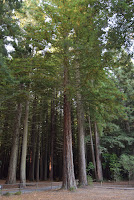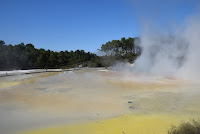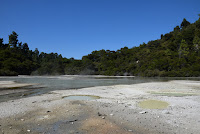We left fairly early in the morning so as to be able to stroll in the 40 square kilometre Redwoods forest prior to visiting the Wai-O-Tapu Thermal park. The Redwoods contain huge groves of redwoods and firs among other plantation trees. Walking along the main track was an interesting experience as the forest closed in on us.



I was particularly impressed by the Cyathea dealbata (known as silver fern), a species of medium-size tree fern recognisable by the silver-white colour of the under-surface of mature fronds. Endemic to New Zealand it is a symbol commonly associated with the country.

I couldn't help noticing the bathroom complex whose outside aspect blended and perfectly fit into the nature environment. I must confess I found it "genial".

We then drove onto the Wai-O-Thermal Park considered as New Zealand's most colourful and diverse geothermal area. The initial part of the track with the fumeroles didn't impress me as much as the hot and cold pools with their variegated colours. Some of them were absolutely stunning, as far as the chromatic aspect is concerned.


Ipu - pools of mud containing unrefined crude oil. In the late 1800s and early 1900s it is said the sludge on the top of these pots was skimmed off to burn in kerosene lanterns. The temperature of this mud is about 50 degrees centigrade.



The artist's palette pool- Being one of the largest of the Wai-O-Tapu thermal park hot water springs, this pool has become known as the artist's palette because of the trace mineral deposits that streak its surface. It is a pity the photograph does not clearly show the various colours which ranged from clear coloured water (alkali-chloride) to cloudy yellow or light green (acid-sulphate), orange (antimony)grey (carbon) and even yellow/green (arsenic and sulphur).

The Champagne pool - Being the largest hot spring in New Zealand measuring 65m diameter and 62m deep with a surface temperature of 74 degrees Celsius its colours are originated by the presence of a number of minerals such as gold, silver, mercury, sulphur, arsenic, thallium and antimony.
It was particularly interesting as seen from a distance.


The boardwalk took us to the Alum Cliffs area. Opposite them we could sea Papa Wera beside an acid lake, which is about 700 years old.




We stopped at every pool and lake so as to get an idea about the whole complex. Along one of the boardwalks I noticed a pine tree chainsaw carving said to have been created by a local artist by the name of Merv Richdale resembling a gecko, one of the two native families of lizard found in New Zealand.



We ended the visit by admiring the Roto Karikitea, a crater filled with excess water from the Champagne pool. The colour of its water was amazing and and said to vary depending on the brightness of the day.
































No comments:
Post a Comment